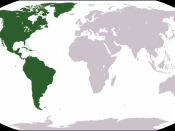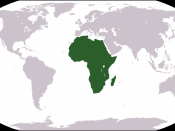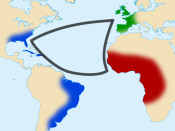The origins of the Atlantic Slave Trade were products of Western Europe's expansion of power that began at the beginning of the 1500's through the 1900's. The main contributing European countries to the Atlantic Slave Trade were Portugal, Spain, the Netherlands, France, and England. Portugal lead the movement during the 1400's and arrived in Western Africa in hopes to find Christian allies to spread Christianity against the Muslims of Northern Africa. But they soon became more interested in trade (Hine, Hine & Harrold, 2011). Slavery, however, has existed in all cultures for thousands of years. For example, Arab merchants and West African Kings imported white European slaves. At first, the slave trade focused on women and children who would serve as domestic servants. But later the trade switched to focusing on young men for agricultural labor in the Americas. The Portuguese traded primarily for gold, ivory, pepper, as well as slaves.
After a few decades, the had captured hundreds of slaves (Hine, Hine & Harrold, 2011). It's misleading to say all slaves were captured by raiders, because in many cases they were bought from African traders.
Columbus's voyages completely changed the slave trade. Once colonies in the Americas were established, many of the Native Americans who were enslaved died of disease and overwork causing a need for more African slaves. During the 1600's, sugar plantations, gold and silver mines produced an enormous demand for labor. Soon after, markets for coffee, tobacco and rice cultivation yet again increased the demand for African slaves (Hine, Hine & Harrold, 2011). By the early 1700's, the English dominated the Slave Trade, carrying about 20,000 slaves per year from Africa to the Americas. By the end of the century, over 50,000 slaves were being transported per year. After 1700, the importation of firearms heightened the...


